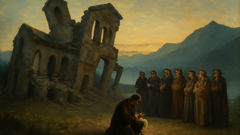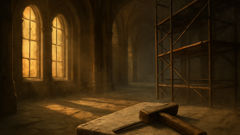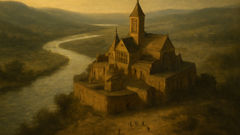Introduction
They built the monastery where the river curved like a shepherd's arm and the wind came down from the mountains carrying old prayers. Villagers called the site a place of blessing and stubborn rock; monks called it a test of faith, and master builders called it an impossible job. The story begins when a prince, proud and pious, resolved to erect a monastery so beautiful that God would approve it from the heavens. Stones were quarried, lime was mixed, and men were paid in grain and wine, but every morning the walls they’d raised fell during the night. Mortar hardened into ruin, arches sagged like tired brows, and by the third winter the prince grew impatient. He offered coin and land to any craftsman who could make the walls stand. From the shadow of the mountains came Master Manole, a man whose hands had the memory of mountains and the patient touch of rivers. He measured the horizon as if reading a long-lost script. There are many versions of what followed: some say Manole bargained with the earth, others that he spoke to saints beneath the soil. What is certain in the telling is the voice that moved through villagers and time—the voice of the builder who knew that certain works ask for more than skill. It is a voice wrapped in the ache of creation, the hush of midnight, and the final echo of a hammer. This is the tale of how a man's devotion and a people's hope collided with a single irrevocable choice, and how the monastery, once completed, kept both its beauty and a secret locked in its mortar.
The Impossible Walls
The prince's proclamation had been public and precise: build a monastery that would stand through time and testify to our piety. Men came from scattered villages, offering their hands for wages and blessings. Master builders argued over foundation depth and mortar mixtures. They drew diagrams in the dust and spoke of wooden scaffolds and clever keystones. Yet every morning the walls lay like someone had scooped them down with invisible hands. Stone by stone and mosaic by mosaic, the work vanished overnight. The village elders called the phenomenon a trial sent by saints displeased by pride. The monks suggested the house needed purer offerings. Superstitions multiplied like moss on the northern stones: spells, jealous rivals, unhappy ghosts, even the notion that the land itself refused to be tamed. Men who had lived and labored beside the river for years grew weary, and the prince's patience thinned into a cold, costly force.

When Master Manole arrived he did not throw stones in anger or light lanterns of complaint. He walked the plot of earth as if reading a poem in the lay of the land. He knelt by the ruined foundations and touched the grain of the stones. He listened to the river’s pattern and to the way the wind wrapped leaves around the lower slopes. Villagers watched him as one watches a rare bird—uneasy hope tucked into the chest. Manole’s reputation had come ahead of him. Stories traveled faster than men: they said he could measure the soul of a thing, that walls built by his hands remembered the craftsman and would not betray him.
He urged the prince to give him time and a small allowance of the choicest timber, but he asked for more than materials. Manole requested the company of twelve skilled masons and the permission to work through nights and fasts. The prince, hungry for success and certain that art could be bought with coin, agreed. Work began anew under Manole’s direction. He drew lines in charcoal that seemed to breathe. He insisted that each block be cut so the stone would read sunlight and shadow like a written language. He taught the masons to listen to the grain beneath their tools and to hold the mortar like a living thing. Even so, neither new method nor extra labor changed what happened at dawn. The overnight collapses continued, and tension knotted the village into whispers.
On a night shrouded in a wind that smelled of far-off rain, the masons stayed awake around the partially raised walls. They drank bitter tea and sang small songs to keep shivers from their hands. Manole worked until the stars tilted and his fingers moved as if they belonged to another weather. He paused on the parapet and watched the river fold itself like a cloth below, thinking. “There is a voice the stones answer to,” he murmured, “and sometimes the voice is not ours.” The men laughed, half in weariness and half in fear. They had heard that the land required something of a different order: a gift, an oath that could not be returned.
That dawn, as the first gray light touched the broken wall, no one was surprised to find the ruin again. Yet within the ruin, secretly, a small difference remained. A single stone at the corner held a dark seam, as though something had been pressed into the mortar and left a shadow. It was not until the third night that a terrified boy who had snuck closer to the work heard breathing from the ruined wall itself—deep and slow like a sleeping beast. He ran and told the monks, who crossed themselves and murmured on wearing out their rosaries. Some called it omen, others a sign that the prince's pride would never be satisfied by mere architecture. The rumor reached Manole's ears like a cool current. He did not flinch. Instead he visited the quarry at dusk, touched each rock, and returned with a single small object wrapped in linen. He carried it into his hut as though it contained a thing both tender and terrible.
When asked by the prince what he planned to do, Manole said simply, “Walls need a heart.” His answer was not given flippantly. In the old rhythm of villages there were stories—older than the prince's family—whispered by grandmothers knitting by the hearth. They spoke of sacrifices that bound stone and spirit so the structure would not separate, of the necessity to leave a trace of living warmth within a cold work. The prince refused to believe that blood and love could be the mortar's missing measure. He offered instead more coin, more men, more speed. For a man such as Manole the offering was never meant to be negotiated into figures of gold. He had learned, in far-off jobs and in long nights, that the measure of some creations was taken in lives.
The night the choice presented itself, the air was a glass of cold wind and hush. Men slept with work shirts still on. Women dreamed of grain and warm bread. The prince lay in his bed, sweating with expectation. Manole gathered his masons and spoke in the low measured voice of someone preparing to cross a spring. He told them the truth that artisans sometimes keep: the work will stand only if someone becomes part of it. The masons recoiled in horror at first. They had families, small children with the soft weight of future suns. But Manole continued with a calm that slashed like a blade made of resolve. He said the sacrifice would be immediate and absolute: the living must be offered, not for power or to sate a curse, but to root the building in flesh and memory. Some laughed; some spat. But the prince, driven by his desire for a monument that would not be shamed by collapse, was not laughing at all. He danced between faith and fury. He argued for alternatives, but Manole’s face was set in a kind of tender stone. “You cannot bargain with a building meant to outlast your blood,” he said. The prince shut himself away to think. Outside, the river moved like an arrow that never acknowledged its target.
As word of what Manole proposed dribbled through the village like spilled milk, fear ripened into a cold, private grief. Mothers kept children close. Sisters hid bread under beds. The masons slept fitfully, clutching their tools. The villagers prayed to saints and to the river. The monks read long passages from ancient books. The air tasted of iron and expectation. That night the three men who had followed Manole from his first jobs—the most stalwart of his band—took their places on the scaffold, and they waited. When dawn painted the monastery in a thin blue, the walls stood. Not a stone moved. The mortar had set like a promise. In the center of the foundation, behind a veneer of perfect stone, they found a small hollow sealed and warm. Inside was a token—woven hair, a palm-bent piece of linen—and the scent of a life that had now been absorbed into the building. The prince wept without shame. The villagers turned away, ashamed of the relief that twined with their sorrow. The monks declared it a miracle and placed prayers beside the token. But Manole's eyes were like a man who has listened too long to an old bell and knows it will toll only for him now. He had given his secret to the wall, and the wall had given it back in staying upright.
The Bargain with Earth and Time
After the first secret offering, the monastery’s walls stayed where they should. The village felt a relief that tasted awkwardly like guilt. The prince celebrated with a feast of wine and roasted lamb; he gave alms and shone in the approval of traveling dignitaries. But Manole's work did not soften into mere craft. He walked the monastery each morning and listened to the mortar for a sound that was never the same twice. The masons worked with reverence, as if the very act of laying bricks had become a liturgy. The building rose with a temperate beauty: arches like bowed prayers, a nave that drank light, frescoes that seemed to breathe. Pilgrims came from far regions to catch a glimpse of what the prince had commissioned, and rumor bloomed. Yet within the walls, even as the stones held, an invisible ledger kept adding entries that no coin could claim.

One evening, as autumn rain stitched the hills together, the prince visited Manole privately. He offered more lands, more titles, more things men often mistake for gratitude. He wanted not only a monastery but the credit for it—the memory to be written on every plaque and in every prayer. Manole accepted gifts with the same stillness with which he accepted storms. He refused, though, the notion that his name should be carved boldly above the doors. “A wall remembers,” he told the prince, “and when one gives a wall a name, it learns vanity and becomes brittle.” The prince, who had wanted a monument both to piety and to legacy, pressed the point. Words can be hammers as strong as any tool. But Manole’s mind had begun to catalogue losses as if reading a ledger of personal cost: nights without sleep, hands cracked, goodbyes that felt like small dying. There was something in him now that understood how art and sacrifice weigh differently on those who make them than on those who receive them.
Not long after, the nights carried a strange chorus: the sound of quiet weeping that no one could trace. Some said it came from the east tower where a mason had hummed through such a long shift he dreamed of mortar. Others said it rose from the plants growing at the foundation, leaves wailing like thin lungs. Manole, who had always been attuned to the small voices of place and material, walked the corridors and listened. He found shadows that had no business living indoors and the smell of something like a half-remembered summer. The monks placed candles, and prayers washed like a tide through the nave. Yet the more prayers they offered, the more vivid the sense became that the building itself held memories that predated their words.
One afternoon, a young woman arrived at the monastery gates carrying a child wrapped in a woolen shawl. Her face was the pale bloom of someone who had walked far and eaten little. She said she had come to thank the master who had made the walls stand, to leave a token for the man whose hands had given a home to their saints. Manole met her beside the courtyard. He saw in her eyes a familiarity that pricked like thorns. She placed a small basket of woven overnight bread at his feet—a humble gift. Something stirred in the pattern of her fingers, in the way she traced the rim of the basket as if naming a face in a crowd. He wanted to ask her where she came from, but he held himself still, letting the small act of gratitude ride into silence.
The winter that followed was hard. Rivers grew teeth of ice; roofs groaned. Men wondered at the cost of a monument that refused to be selfish. Manole began to dream in stone. He would wake at odd hours and rub his palms as if he could coax a living warmth from plaster. The masons noticed the change. He spent longer in the quarry, speaking to the selected blocks as if to children. One evening he returned with new tools—blunt planes and sanding stones—so that each face of every block might read as if it had been kissed rather than carved. But the higher the monastery rose, the more fragile the social fabric below shivered. Men who had once laughed at superstition now whispered about debt owed to walls. Families who had once been neighbors began to look at one another with the caution of creditors.
The prince grew impatient again. He wanted the cathedral finished before spring, so he could host a grand consecration, and perhaps, in the wake of such a spectacle, secure a legacy that would be spoken for generations. Manole told the prince he needed more time and none of the trappings offered: no banners, no bells bearing the prince’s signet. The prince, unaccustomed to a craftsman’s refusal, saw stubbornness where Manole meant restraint. In a moment of temper he demanded that Manole finish by Easter, or the contract would be reassigned. It was an impossible order. Manole took one long breath and then, in quiet, retreated to the place no public eye would enter. He took with him the women’s basket that had been left earlier and a scrap of cloth from his own tunic. He walked beneath the arches as if they were ribs and found a hollow at the very center of the new nave—an old foundation gap left from the first, failed attempt. He sat and held his hands over it. The hollow answered like a throat.
There is a kind of silence that sounds like an understanding. In that hour Manole thought of the things he loved: a mountain ridge traced at dusk, the way a river would fold light when it had nothing else to say, the face of a wife he might have married in a life that chose not to be. He thought of the masons who had followed him and the prince who could not see beyond his own reflection. He thought of the villagers who came to the monastery with bread and candles. He thought of the little child in the young woman’s basket—how a small life might one day kneel in that nave and call the stones home. The building was becoming a place for people to lay down their griefs and find a steadier earth. Yet to make it so, Manole understood that he could not count on offerings or on vows alone. The structure required a presence that could anchor it to the imperishable. In the old stories he had been told as a boy there were always whispers of a builder’s heart needing to be stilled so the house would sing. He realized then that the bargain he had made was not only with the earth; it was with time itself. He would give whatever the building needed to remain, and that whatever would be of him.
He did not tell the prince. He did not rescue his own name from the ledger. Instead he prepared, speaking softly to the masons he trusted most, asking them to finish the next day's work with hands that knew the rhythm. To those men he gave the woman’s bread and the scrap of cloth, telling them only to remember. They looked at him as if he had become a man older than his face. The morning Manole chose to make the final offering, the sky hung low and silver. He climbed the scaffold and placed his hands on the stone he had shaped since youth. He closed his eyes and listened to the whole of the building—its beams, its arches, the whispers that had gathered like dust. He thought of the river and its patient speech and felt an acceptance like peace, not the kind that erases, but the kind that completes. Then he stepped forward and became a part of the very thing he had crafted. The story of that moment moved into legend the way a small river widens into a story that will not be contained. Men later said he had been buried alive in the heart of the wall. Others said he moved into the mortar like a spirit that would never leave. What is true is that the work that followed his final act held differently than it ever had: no more collapses, no more ruined dawns. The monastery rose with a steadiness like an animal breathing in sleep, and when it was finally consecrated, people wept for joy and with regret as if both could exist without denying the other. For the prince, there was a triumph; for the villagers, a temple; for Manole, an eternity folded into lime and stone.
After the consecration, travelers whispered of an invisible warmth at the monastery's heart. Craftsmen who visited said the stone seemed to answer them with a softer voice. Pilgrims left ribbons and small trinkets in small nooks, and the monks kept vigil with prayers that now felt heavier and more honest. Manole's name faded from the plaques and the prince's heralds argued in court about rights and grants. But in the quiet of certain nights, when the wind moved down from the ridge like an old regret, people would say they heard the rhythm of a hammer—slow and gentle—the sound of a man who had become a foundation. The bargain was sealed: the monastery would stand, and the cost would be carried in the memory of a small, unmarked heart embedded in the wall. The villagers carried on, their lives stitched to the monastery's outline, and though they rejoiced, they never entirely let go of the ache that narrated what had been required for beauty to endure.
The Legacy of Stone and Quiet
Years later, people would tell stories of Master Manole in the hush of winter, when coal smoke and candlelight softened wrinkles into maps of memory. Children clung to tales told by their grandmothers about a builder who vanished into mortar like sugar dissolving in tea. Some versions turned him into a saint who walked at dawn, others into a cautionary figure who taught that pride and ambition can demand the highest price. But when the retellings grew loud with the embellishments of passing tongues, the truth of the place remained quieter, folded into the grooves of the stones and the hum of bees in summer. The monastery stood as promised: a place where light fell in patient shapes and where travelers found shelter. The architecture kept its promise of endurance, but it also held a soft sorrow that travelled like breath among the columns.

The prince who commissioned the monastery grew old and less pleased with the world. He sat on a terrace overlooking the river and wondered at the cost of monuments. Titles meant little at the end of years when the memory of a single human life hung like a secret in the place you had tried to immortalize. He visited the monastery often, sometimes with wine and laughter, sometimes in a silence that tasted of ash. He sought to atone in small ways: a bell here, alms there. Yet nothing could replace the living craftsman who had given himself so the work could stand. The villagers continued to bring bread and flowers to the monastery gates, and once a year they held a small vigil for the builder who had become part of the walls. They circled the nave with candlelight and offered a quiet song for the man who had paid a price that stitched their faith to stone.
Scholars who visited the monastery centuries later traced the workmanship to a school of masons whose designs echoed across the region. They cataloged techniques and patterns, and some wrote footnotes about an enigmatic master who preferred anonymity. Poets came to sit in the nave and try to press words into the space where voice had been replaced by stone. Their poems were full of longing and the sort of reverence one pays to objects that bear witness to things beyond everyday reckoning. But the simplest miracles lived in the small corners: a child born in the village whose first steps were named after a saint and who would always associate the sound of prayer with a slow rhythm like hammer on stone; a keeper of the monastery who set a cloth on a window ledge and left incense there for reasons he could no longer say; a mason who, years after working on the building, felt his hands twitch toward the motion of laying mortar when nervous. The building had become a repository of acts, and those acts carried traces of living bodies that had entered the work.
Generations passed. Wars came and retreated like storms. The monastery weathered both and, in the process, became tangled in more than the faith that birthed it. It collected history like lichen: treaties were signed at its gates, lives ended in its courtyards, children learned their letters inside its shadow. It was a place of many claims, belonging partly to saints, partly to cronies of power, partly to a village that had long since scattered. Through all this, the small secret in the heart of the wall remained exactly that: a heartbeat the building no longer needed to sustain itself but would not, for the sake of memory, reveal.
Pilgrims still came to the monastery not only for devotion but to rub their hands on the warm stones and to press coins into its cracks. They believed those stones granted something—forgiveness, health, the luck of steady hands. Occasionally, someone would report a dream of a man at work within the walls, a man who did not speak but whose presence made the dreamer whole. Others reported a steady, distant tapping in the deep of night, as if a small hammer still marked time with the patience of someone who had accepted an irrevocable bargain. Travelers sometimes asked the monks if they could enter the wall to find the remains of the builder. The monks refused; they had their own silence to keep and their own prayer that did not require excavation. They maintained their candles and their books and taught the children to read in the echoing quiet of the nave.
Years turned into decades, and each person who entered the monastery added to its story. Lovers carved initials into a rear stone; a widow leaned her forehead against a pillar and wept; a little boy found his first courage there and later became a mason who would trace the same motions as his forebears. Those delicate human acts stitched the building closer to people than any architectural plan could claim. The monument ceased to be only a testament to a prince's hopes and became instead a living collage of human longing, grief, love, and the ordinary decisions that define us.
Yet for all the tenderness and duty that congregated in that place, the villagers never fully let go of the memory of what had been required. On market days, older women would touch a seam in the stone and cross themselves. Men would stand and say the builder had given them a place to pray and also demanded a debt they had no way to repay. They passed the story of Master Manole on with a friction-less sadness. It was told not simply as lore but as an admonition: beauty sometimes costs dearly, and those who march forward chasing grandeur must look at where their hands will rest when the work is done.
Modernity braided into the countryside slowly and with peculiar manners. New roads shortened the distance to other towns; radios shouted into kitchens; scholars arrived with notebooks and theories. Yet the monastery retained the air of a thing slightly older than the world around it. Tourists stood on its terraces and took photographs, clicking like small mechanical prayers. Some saw only stone and sky. Others knelt and felt the weight of a man who had given himself to a craft that asked for more than skill. For them, the sight was both beautiful and unbearable. They touched the cool stone and imagined the soft risk of giving oneself wholly to a purpose. The monastery still taught its lesson: the cost of permanence could be human and exacting.
And so the legend continued: Master Manole’s name becoming both a warning and a quiet benediction. People who heard the tale felt both moved and unsettled, stirred by the knowledge that a single life, given as binding, could change how a community remembered itself. The monastery remained, its silhouette a steady answer against the sky, and within its bones the story of one artisan's sacrifice moved like a small, indestructible pulse. It taught that some gifts ask for a presence, not coin; that things built to outlast the human span may hold the imprint of a life taken into their making; and that memory, once wrapped in stone, becomes a quiet guide to those who come after. The villagers continued to keep their silent vigil, and the monastery, in turn, kept its gentle watch over the curve of the river, holding firm the traces of a man who had become forever part of what he had built.
Conclusion
The legend of Master Manole endures because it asks a question as old as craft: what are we willing to give so beauty lasts? It is not an easy question, and the answer is messy. The monastery stands as both a marvel and a memorial, its walls holding the warmth of a life that once belonged solely to a man. Villagers still come with bread and candles. Pilgrims still leave ribbons in crevices. Scholars still debate the historical truth of that which the legend compresses. In the hush of dusk, when bell and wind overlap, the teachings of the tale are clear—creation is never costless; permanence requires the courage to offer something beyond currency. Master Manole's story teaches reverence for the labor of hands, for the quiet debts communities sometimes carry, and for the tender reckoning that follows beauty birthed with sorrow. The monastery, with its steady stones and shadowed corners, continues to shelter lives, arguments, births, and deaths. In every breath the structure holds, there is a memory tucked like a small stone in a pocket. And each time someone lays a palm against the cool surface, they feel—if only for a moment—the pulse of a man whose work, in the end, became the place where a people could keep their faith and their regrets together. That is the legacy of Master Manole: not simply a monument of stone, but a living, aching testament to how far human hands will go to make something last.













